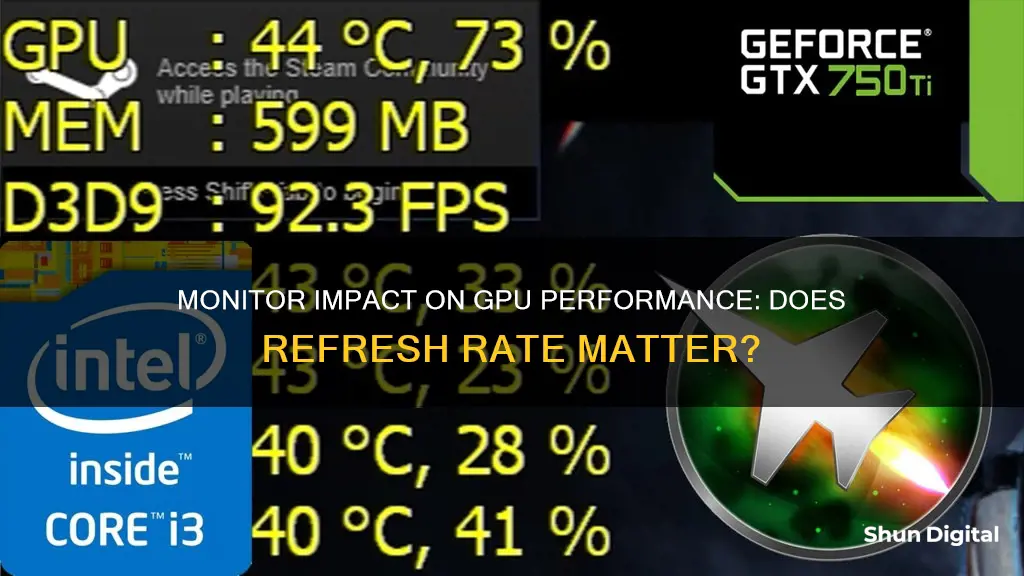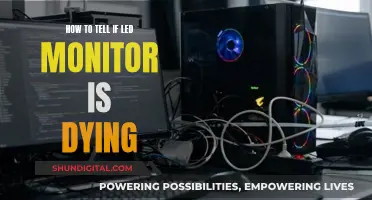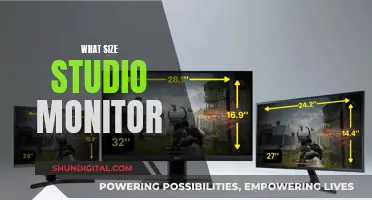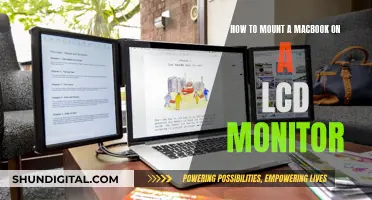
The size of a monitor does not affect GPU performance, but its resolution does. A GPU renders pixels, so a higher resolution means more pixels for the GPU to process, which impacts performance. For example, a full HD monitor will put less strain on a GPU than a 4K monitor. Similarly, a lower resolution will result in a higher number of pixels on the screen, causing a strain on the GPU. Therefore, it is important to consider the resolution when choosing a monitor to ensure optimal GPU performance.
| Characteristics | Values |
|---|---|
| Resolution | The higher the resolution, the more work the GPU has to do. A GPU renders pixels, so more pixels mean the GPU has to work harder. |
| Response Time | A monitor with delays can put you at a disadvantage in fast-paced games. |
| Refresh Rate | A higher refresh rate will require a better graphics card. |
| Physical Dimensions | A larger screen makes smaller things appear larger at the same resolution. |
What You'll Learn

Monitor resolution affects GPU performance
The resolution of a monitor has a significant impact on GPU performance. A GPU's job is to render pixels, and higher resolutions mean more pixels, which in turn means the GPU has to work harder. This results in lower frame rates unless you turn down some settings. A monitor with a lower resolution will put less strain on your GPU, allowing for higher frame rates and additional graphical settings.
For example, a video card that cannot play a game smoothly above 30fps at 1080p may be able to maximise the game's settings and run it at 60fps at 720p. This is why laptop integrated graphics often seem to perform well—they are running the game at a lower resolution.
The size of a monitor does not affect GPU performance, but it does affect the viewing experience. A larger screen makes targets in games easier to spot, for instance. However, if a screen is too large, it may take up too much of your range of vision, requiring you to pay closer attention to your peripheral vision, which can be a disadvantage in fast-paced games.
Monitor resolution also affects the amount of VRAM (Video Random Access Memory) required to store textures in a game. Higher resolutions like 1080p+ require more VRAM.
In summary, while monitor size does not directly affect GPU performance, resolution plays a crucial role in determining the workload of the GPU and the overall gaming experience.
Best Monitor Size for FPS Gaming Experience
You may want to see also

Monitor delay affects GPU performance
Monitors can affect GPU performance in several ways. Firstly, the resolution of a monitor determines the amount of work the GPU needs to do to display an image. Higher resolutions mean more pixels, which increases the computational load and vRAM usage for the GPU. As a result, a GPU may struggle to maintain high frame rates at higher resolutions.
Another factor is the physical size of the monitor. A larger screen can make targets easier to spot in games, enhancing performance. However, if the screen is too large, it may take up too much of the player's field of vision, requiring them to pay closer attention to their peripheral vision, which can be disadvantageous in fast-paced games.
Additionally, input lag, or the delay between the graphics card sending a frame to the monitor and the monitor displaying it, can impact GPU performance. Monitors with high input lag may put players at a disadvantage in games where reaction speed is crucial. The signal delay, which is a component of input lag, can be reduced by using a dedicated mode that bypasses signal processing or enabling a low input lag setting.
The refresh rate of a monitor also plays a role in performance. Higher refresh rates reduce the gap between frames, leading to smoother and more fluid visuals. This is particularly beneficial for gamers as it enhances responsiveness and improves the overall gaming experience.
Lastly, the type of connection between the monitor and the GPU can impact performance. Using a connection such as DisplayPort or USB-C instead of HDMI can provide higher data transfer rates and reduce potential delays.
Vertical Monitor Buying Guide: Choosing the Right One
You may want to see also

Monitor size affects gaming experience but not performance
The size of a monitor does not affect GPU performance. However, it can impact the gaming experience. A larger screen can make targets easier to spot in shooting games, for example. But a screen that's too big can be cumbersome and cause you to move your head to see the corners of the screen.
Resolution, on the other hand, does impact GPU performance. A higher resolution means more pixels for the GPU to process, which requires more computations and vRAM usage. So, a 1080p resolution is better suited for a 21-24 inch monitor, while a 27-33 inch monitor would be better for 1440p, and 4K resolution is ideal for screens 34 inches and above.
Other factors that can affect gaming performance include the monitor's response time and refresh rate. A monitor with a high response time can put you at a disadvantage in fast-paced games. A 5ms or lower response time is generally recommended. Additionally, a higher refresh rate can improve performance by allowing the monitor to refresh the image more quickly.
Finding the Perfect Studio Monitor Sweet Spot
You may want to see also

Monitor brand/model does not affect GPU performance
The monitor brand or model does not affect GPU performance. However, the resolution and physical dimensions of a monitor can impact gaming performance. A monitor with a higher resolution will require the GPU to render more pixels, resulting in increased computational demands and vRAM usage.
For instance, a GPU that struggles to play a game smoothly at 30fps and 1080p resolution may achieve better performance at 60fps when the resolution is lowered to 720p. This is because the GPU has fewer pixels to render, reducing the strain on its resources.
The physical size of a monitor also matters in terms of gameplay experience. A larger screen displaying the same resolution will make targets easier to spot in a game. However, an overly large screen can become a hindrance if it takes up too much of your field of vision, requiring you to pay closer attention to your peripheral vision.
Additionally, the refresh rate and response time of a monitor are crucial factors in gaming performance. A monitor with high response times or delays can put you at a disadvantage in fast-paced games where quick reactions are crucial.
In summary, while the specific brand or model of a monitor does not directly influence GPU performance, the resolution, size, refresh rate, and response time of the monitor can significantly impact your gaming experience.
Blind Spot Monitoring: Ram Rebel's Safety Feature
You may want to see also

GPU renders pixels, so higher monitor resolution means more work for the GPU
The GPU (Graphics Processing Unit) is responsible for rendering pixels to create an image or sequence of images. The GPU computes these pixels in parallel, meaning it can process many tasks simultaneously. This is why GPU rendering is generally faster than CPU (Central Processing Unit) rendering, which processes serially.
The resolution of a monitor determines the amount of work the GPU needs to do to display an image. A higher resolution means more pixels, which translates to more work for the GPU. This results in increased computations and higher VRAM usage. Consequently, a GPU may struggle to play a game smoothly at higher resolutions, such as 4K, and may need to have some settings adjusted to achieve higher frame rates.
For example, a GPU that cannot maintain 30fps at 1080p may be able to achieve 60fps at 720p. This is why laptop integrated graphics often seem to perform well, as they are rendering at a lower resolution. Therefore, when selecting a monitor, it is important to consider the resolution and ensure that your GPU can handle the increased workload that comes with higher resolutions.
Hooking Up Three Monitors to NVIDIA 920: A Step-by-Step Guide
You may want to see also
Frequently asked questions
Yes, the resolution of a monitor determines the amount of work the GPU needs to do to display an image on it. The higher the resolution, the more work the GPU has to do.
No, the physical size of the monitor does not affect GPU performance. However, a larger screen may make it easier to spot targets in video games.
Yes, having a second monitor can cause a small drop in FPS, especially if it is being used for something like streaming video. This is because the graphics card has to do multiple things at once.
Yes, monitors with high delays can put you at a disadvantage in fast-paced games where reaction speed is crucial.
No, as long as the resolution is the same, the performance will be the same.







